
views
Heating a Croissant in the Oven

Place the croissants on a baking sheet. Lay the croissants on a baking sheet with the cut-side down. To keep the croissants from sticking, you can either line the sheet with parchment paper. If you're worried about burning the tops/bottoms, double up on your sheet pans (use 2 stacked on top of each other). That will give it some extra insulation so the bottoms won't burn. If the croissant isn't warm enough but it's starting to get too brown, lay some foil directly on top of it.
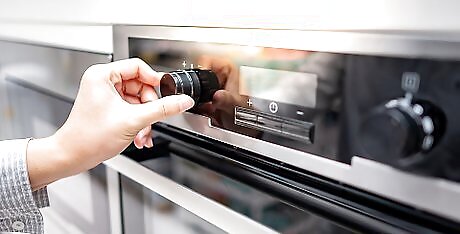
Allow your oven to preheat. Heat the oven to 400 °F (204 °C). Then, place the baking sheet containing the croissant in the oven.

Bake for five minutes. Set a timer. Heat the croissants for about five minutes so they're warmed and slightly toasted. When done, the bread will be slightly firm and crispy.

Add your chosen toppings, if you'd like. Croissants are often topped with butter and jam. However, you can add whatever toppings you want. If you want something more savory, for example, you can top a croissant with mustard and a few slices of deli meat. You can also use croissants in place of bread for a tasty breakfast sandwich. Try putting an egg and a slice of cheese between two croissants.
Heating a Croisant in the Toaster

Cut the croissant in half. Use a serrated knife to gently cut the croissant in half. Use a sawing motion to avoid tearing the croissant.

Place the croissant in the toaster. Gently slide each side of the croissant into one side of the toaster. Again, go slow. Using too much force could cause a croissant to crumble.
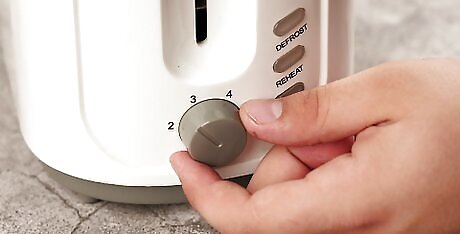
Toast your croissant for short intervals. Different toasters have different heat settings and it's hard to tell exactly how long something will take to heat up. It's a good idea to heat your croissant in small intervals and check it every two or three minutes to see if it's crisped and mildly browned. Croissants are light pastries, so they tend to burn easily. For best results, err on the side of caution and start with a lighter setting. If your croissant is not toasting fast enough, you can increase the heat to a higher setting.
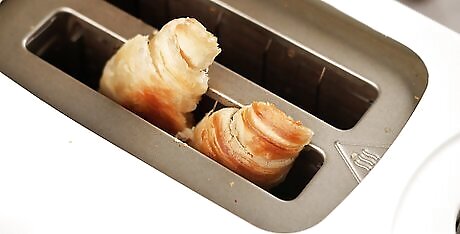
Opt for the oven if your toaster's not big enough. Croissants are a very delicate pastry. If your croissant does not easily fit into a toaster, it's best to heat the croissant in the oven to avoid breaking it.
Baking a Raw Croissant
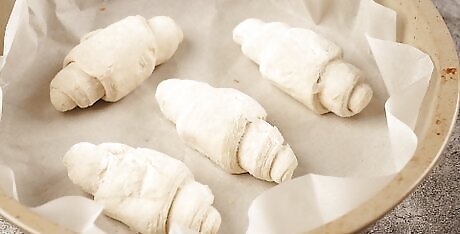
Proof the croissants first. Before you heat raw croissants, they need time to proof. Place your raw croissants on a baking sheet covered in parchment paper. Set the tray in an area in your home where the temperature is between 75 °F (24 °C) and 80 °F (27 °C). Let them sit for an hour to 90 minutes. When completely proofed, you will be able to see clear layers when you view the croissants from the side. Also, if you gently shake the tray, you should see the croissants wiggle slightly. Note: This doesn't apply to pre-made croissants that you roll out of a tube.
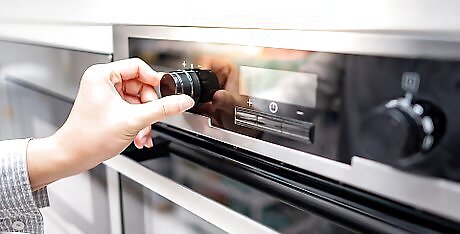
Heat your oven. In most recipes, croissants should be baked at 400 °F (204 °C). However, check the recipe you're using or the package the raw croissants came in. The precise temperature varies.
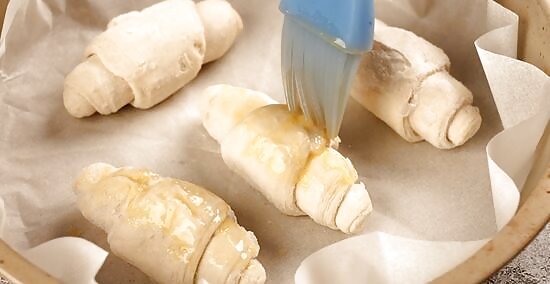
Brush the croissants with an egg wash. Beat one egg in a mixing bowl using a wire whisk or fork. Use a baking brush to brush each croissant with the egg wash, coating the top and sides. Make sure each croissant is covered in a full layer of egg wash. You can also make an egg wash with an egg, a splash of water, and a pinch of salt.
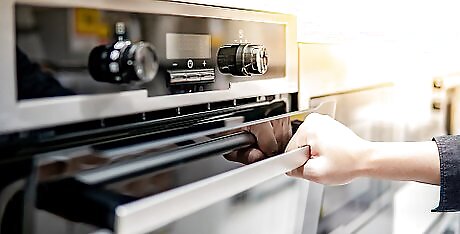
Arrange the oven racks. Place one oven rack on the upper third of the oven. Place the other rack on the lower third of the oven.

Place the croissants in the oven. If you're using two baking sheets, put one in the top rack on one on the bottom rack. If you're only using one sheet, put it on either the top or bottom rack. It does not matter which rack your croissants start baking on.

Switch the positions of the croissants after 10 minutes. Set a timer for 10 minutes. When the timer goes off, rotate the croissants. Either move the single tray from one rack to other other or swap the positions of the trays if you're using two.

Bake the croissants for an additional 8 to 10 minutes. When done, the croissants should have an even brown color throughout. The edges should be slightly darker.

Cool the croissants. Remove the croissants from the oven. Place them on baking racks to cool before eating them. Cooling times will vary, but most baked goods cool down within 10 to 20 minutes.

Store the croissants. Any croissants you don't eat right away can be wrapped in aluminum foil or sealed in a plastic bag. You can store the croissants in the pantry or counter or refrigerate them. Croissants keep for two days in the pantry and up to a week in the fridge.
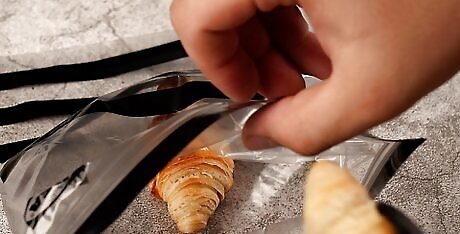
Increase the shelf life by freezing croissants. Frozen croissants will keep for up to a year. Wrap them in plastic before placing them in an airtight bag. Thawing times depend on the precise heat of your home, but most croissants will thaw within 24 hours. Croissants can also be reheated right away in the oven without being thawed first, but you'll have to add onto the normal reheating time. Bake for about seven minutes and then check them, continuing to add time until the croissant is heated.

Finished.


















Comments
0 comment